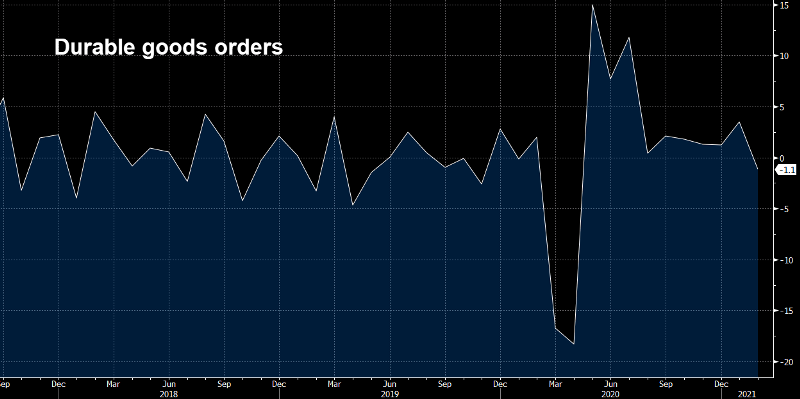US Durable Goods Orders Turn Negative, But Services and Manufacturing Remain Upbeat
Durable goods orders declined for the first time since last April
•
Last updated: Wednesday, March 24, 2021

The US manufacturing and services PMI reports were released a while ago today, showing some cool off. Although, manufacturing and services remain in decent shape, around 60 point. Durable goods orders turned negative in January. Although this comes after orders remained positive for about a year and after a strong reading in December, as we covered in our economic calendar.
US February Prelim Durable Goods Orders
- February prelim durable goods orders -1.1% vs +0.5% expected
- Prior was +3.4% (revised to +3.5%)
- Durables ex transportation -0.9% vs +0.5% expected
- Prior ex transportation +1.3% (revised to +1.6%)
- Capital goods orders non-defense ex-air -0.8% vs +0.5% expected
- Prior capital goods orders non-defense ex-air +0.4% (revised to +0.6%)
- Capital goods shipments non-defense ex-air -1.0% vs -1.0% expected
- Prior capital goods shipments non-defense ex-air +1.8% (revised to +1.9%)
This is a soft report and the first big miss in awhile but the market reaction has been minimal. This is the first decline since last April so the market is likely to forgive it, especially if the Markit manufacturing survey at 1345 GMT is strong.
Markit US March Prelim Services and Manufacturing
- March prelim services 60.0 vs 60.1 expected
- Prior was 59.8
- Manufacturing 59.0 vs 59.5 expected
- Prior manufacturing 58.6
- Composite 59.1 vs 59.5 prior
- Services new business at highest since June 2014
- Full report
These numbers are a touch soft compared to expectations but the services survey is at the highest since July 2014, so it’s hardly bad news.
The cost side is interesting with services input prices at 72.7 vs 70.1 at the highest since the survey started in 2009. Admittedly, that’s not a long track record.
It’s a similar story in manufacturing with input prices at 74.9, which is the highest since March 2011.
The report touches on some of the reasons for higher prices and the ramifications:
Unprecedented supply chain disruptions pushed price gauges higher once again. The overall rate of input cost inflation accelerated to the fastest on record as raw material, PPE and fuel prices reportedly soared. Stronger demand conditions allowed for the partial pass-through of costs to clients, with the overall pace of selling price inflation also hitting the sharpest on record.
Here is Markit chief economist Chris Williamson:
“Another impressive expansion of business activity in March ended the economy’s strongest quarter since 2014. The vaccine roll-out, the reopening of the economy and an additional $1.9 trillion of stimulus all helped lift demand to an extent not seen for over six years, buoying growth of orders for both goods and services to multi-year highs.“Producers were increasingly unable to keep pace with demand, however, due mainly to supply chain disruptions and delays. Higher prices have ensued, with rates of both input cost and selling price inflation running far above anything previously seen in the survey’s history.”
- Check out our free forex signals
- Follow the top economic events on FX Leaders economic calendar
- Trade better, discover more Forex Trading Strategies
- Open a FREE Trading Account
ABOUT THE AUTHOR
See More
Skerdian Meta
Lead Analyst
Skerdian Meta Lead Analyst.
Skerdian is a professional Forex trader and a market analyst. He has been actively engaged in market analysis for the past 11 years. Before becoming our head analyst, Skerdian served as a trader and market analyst in Saxo Bank's local branch, Aksioner. Skerdian specialized in experimenting with developing models and hands-on trading. Skerdian has a masters degree in finance and investment.


